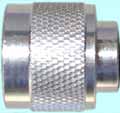

| Contact Us | FAQ | Features | Test Frequencies | Test Process | Test Report | Home |
Our Field Service Grade RF test cables include all the following features.
Designed, engineered, and manufactured for ruggedness and field survivability.
|
Cable – Selected for excellent shielding, good flexibility, excellent crush resistance, very good loss stability, and minimal "ripple" in the insertion loss vs. frequency. Our cable is fully qualified MIL-C17-Spec. This means the manufacturer tests and certifies the cable. We completely test the entire cable assembly and document the test results. |
 |
|
Caps – Protective caps are provided for our cable connectors. The caps prevent damage and debris entry to the connector. Please use the caps when the test cable is not in use or stored. You might want to keep the caps in place if you're stretching the cable across a site with battery backup. We've seen what happens when a test cable connector came in contact with the battery hot side. It wasn't pretty - lot's of sparks and angst. Keep the plastic cap on and you may prevent an "interesting" episode like this! |
 |
|
Color Coded Braid - We add an overall mesh braid for superior abrasion resistance and cable protection. We normally provide colors meant to enhance the safety of RF equipment testing. Standard colors are Red for transmitter test cables, Blue for receiver test cables, and White for general purpose use. Black, Green, Orange, Purple, and Yellow are also available. |
 |
|
Connectors – For most connector types we do not use nickel plating. Silver offers much better repeatability for the high number of on/off cycles a field test cable endures. Eventually, the silver will wear and/or corrode. This actually provides a useful indication of when to replace the connector (which should be done for ANY test cable when the connector’s on/off number of cycles is exceeded). Our test cables are inherently low PIM with options available for even lower PIM with BNC and N connector types. |
 |
|
Packaging – A soft plastic container is provided with each cable. A major source of damage to test cables is to have loose cables rattling around in a tool box. The case prevents damage and makes finding and organizing your cables easier. |
 |
|
Serialized – All cables are provided with a unique serial number for traceability and documentation purposes. |
|
|
Strain Relief – We use a proper strain relief to minimize the cable stress at the end of the connector crimp. This is where most cable failures occur with usage. A stiff heat shrink relief does not allow proper flexure of the cable, it just moves the point of most likely failure to the end of the heat shrink. |
 |
|
Test Report – All our cables are provided with complete test data including insertion loss from 100MHz to 1100MHz (other frequency ranges available). A label is attached to the cable that documents the cable insertion loss in the common LMR frequency bands (150, 450, 800). Label data can be customized at your request. |
 |